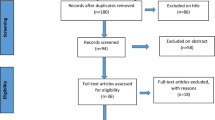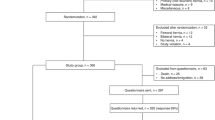Abstract
Purpose
Persistent inguinal pain, influencing daily activities, is seen in about 5 % of patients following inguinal herniorrhaphy. Surgical treatment of patients with persistent postherniorrhaphy pain has been associated with pain relief and improvement in functional status. However, the detailed long-term outcome effects remain to be clarified. The aim of this study was to determine the long-term effects of mesh removal and selective neurectomy in patients with persistent postherniorrhaphy pain after previous open repair.
Methods
The study consecutively included 54 inguinal postherniorrhaphy pain patients treated with mesh removal and aimed neurectomy. Patients completed questionnaires evaluating pain intensity with a numerical rating scale (NRS) and pain-related functional impairment preoperatively, and, 3, 6, 12, 24, and 36 months postoperatively. Endpoints were changes in pain intensity and functional ability when comparing preoperative and postoperative assessments.
Results
Pain intensities (average, maximum, and during activity) were significantly lower at all time points during follow-up compared to preoperative values (p < 0.01 for all) with a reduction in median (IQR) average pain intensity from 6.0 (5.0–7.0) preoperatively to 3.0 (1.0–5.5) at 36-month follow-up. There was no association between positive pain outcome and intraoperative nerve identification (p = 0.47). The number of patients who reported a long-term negative effect of the operation (≥25 % increase in average pain intensity at 36-month follow-up) was 1 of 8. The functional ability was improved at 3 months after the operation (p < 0.01), but the improvement was not statistically significant in the follow-up period. Preoperative signs of depression, anxiety, and catastrophizing had no influence on outcome.
Conclusions
Mesh removal and attempted neurectomy may provide long-lasting analgesic effects in most patients and with a small proportion being worse, without relation to pain history and operative findings. Detailed multicenter collaboration is required to define preoperative diagnostics and the indication for mesh removal and neurectomy, the exact surgical procedure (type of neurectomy) and with detailed follow-up.


Similar content being viewed by others
References
Aasvang E, Kehlet H (2005) Chronic postoperative pain: the case of inguinal herniorrhaphy. Br J Anaesth 95:69–76
Simons MP, Aufenacker T, Bay-Nielsen M et al (2009) European Hernia Society guidelines on the treatment of inguinal hernia in adult patients. Hernia 13:343–403
Amid PK (2004) Causes, prevention, and surgical treatment of postherniorrhaphy neuropathic inguinodynia: triple neurectomy with proximal end implantation. Hernia 8:343–349
Loos MJ, Scheltinga MR, Roumen RM (2010) Tailored neurectomy for treatment of postherniorrhaphy inguinal neuralgia. Surgery 147:275–281
Aasvang EK, Kehlet H (2009) The effect of mesh removal and selective neurectomy on persistent postherniotomy pain. Ann Surg 249:327–334
Keller JE, Stefanidis D, Dolce CJ, Iannitti DA, Kercher KW, Heniford BT (2008) Combined open and laparoscopic approach to chronic pain after inguinal hernia repair. Am Surg 74:695–700
Zacest AC, Magill ST, Anderson VC, Burchiel KJ (2010) Long-term outcome following ilioinguinal neurectomy for chronic pain. J Neurosurg 112:784–789
Amid PK, Hiatt JR (2007) New understanding of the causes and surgical treatment of postherniorrhaphy inguinodynia and orchalgia. J Am Coll Surg 205:381–385
Vuilleumier H, Hubner M, Demartines N (2009) Neuropathy after herniorrhaphy: indication for surgical treatment and outcome. World J Surg 33:841–845
Amid PK, Chen DC (2011) Surgical treatment of chronic groin and testicular pain after laparoscopic and open preperitoneal inguinal hernia repair. J Am Coll Surg 213:531–536
Giger U, Wente MN, Buchler MW, Krahenbuhl S, Lerut J, Krahenbuhl L (2009) Endoscopic retroperitoneal neurectomy for chronic pain after groin surgery. Br J Surg 96:1076–1081
Delikoukos S, Fafoulakis F, Christodoulidis G, Theodoropoulos T, Hatzitheofilou C (2008) Re-operation due to severe late-onset persisting groin pain following anterior inguinal hernia repair with mesh. Hernia 12:593–595
Hakeem A, Shanmugam V (2011) Current trends in the diagnosis and management of post-herniorrhaphy chronic groin pain. World J Gastrointest Surg 3:73–81
Aasvang E, Kehlet H (2005) Surgical management of chronic pain after inguinal hernia repair. Br J Surg 92:795–801
Zigmond AS, Snaith RP (1983) The hospital anxiety and depression scale. Acta Psychiatr Scand 67:361–370
Sullivan MJL, Bishop SR, Kivik J (1995) The pain catastrophizing scale: development and validation. Psych Assess 7:524–532
Aasvang EK, Bay-Nielsen M, Kehlet H (2006) Pain and functional impairment 6 years after inguinal herniorrhaphy. Hernia 10:316–321
Acknowledgments
The research leading to these results is part of the European Collaboration, which has received support from the Innovative Medicines Initiative Joint Undertaking, under Grant Agreement No 115007, resources of which are composed of financial contribution from the European Union’s Seventh Framework Programme (FP7/2007-2013) and EFPIA companies’ in kind contribution. The authors thank Morten Bay-Nielsen for surgical collaboration.
Conflict of interest
None declared.
Author information
Authors and Affiliations
Corresponding author
Rights and permissions
About this article
Cite this article
Bischoff, J.M., Enghuus, C., Werner, M.U. et al. Long-term follow-up after mesh removal and selective neurectomy for persistent inguinal postherniorrhaphy pain. Hernia 17, 339–345 (2013). https://doi.org/10.1007/s10029-013-1073-z
Received:
Accepted:
Published:
Issue Date:
DOI: https://doi.org/10.1007/s10029-013-1073-z




